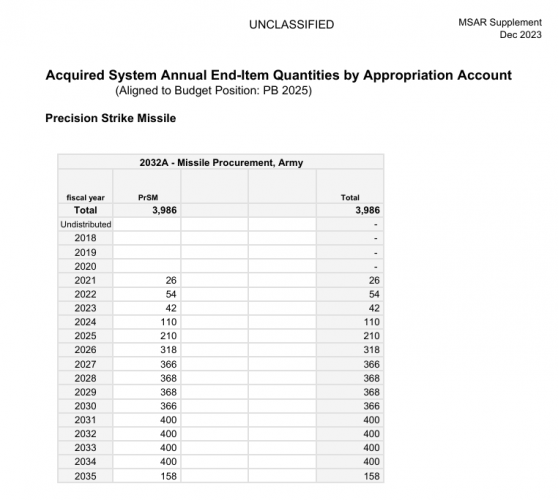bring_it_on
I really should change my personal text
- Joined
- 4 July 2013
- Messages
- 3,608
- Reaction score
- 3,639
Uh
increment 1Are they increment 1 or increment 2 missiles?
increment 1Are they increment 1 or increment 2 missiles?
I think that's due to paint...2 successful PrSM tests. Seems to look narrower at the tail in this shot.
[...]
View attachment 759459
I think that's due to paint...
Could be.It sort of looked like soot to me.
I asked again because I didn't get a reply.
It's an optical illusion. Imagine the black propellant residue was scrubbed off.2 successful PrSM tests. Seems to look narrower at the tail in this shot.
View: https://x.com/AirPowerNEW1/status/1890389709014151534
View attachment 759459
You could have simply answered the question the first time.Entitled much?
You could have simply answered the question the first time.
"No, haven't seen a designation in any open literature."
Takes 10 seconds.
Every question? No.I don't take the time to answer every question I don't have an answer to. Do you?
Especially when he asks the same question over and over again. He asks basically every time PrSM gets mentioned.
Every question? No.
One that's on my mind as well? Yes.
But I'm starting to suspect that PrSM will never get an official MDS designation, nor an M-series number. Just like THAAD.
Can't tell if the prevailing attitude is "don't know" or "don't care", when it comes to designations.THAAD has at least a MDS-like number.
THAAD has at least a MDS-like number.
Designation Note: No confirmed formal alphanumeric designation for the THAAD missile is known. While there are a few isolated references in Army logistics and training files to a "Guided Missile, Intercept-Aerial, THAAD MIM-401" and "Guided missile sub-system, intercept-aerial MIM-401B" (and -401C), it is far from certain, that the MDS designator MIM-401 has really been officially allocated to THAAD. The number 401 would be way out of sequence, and DOD MDS records up until January 2024 don't include any MIM-401 designation. Also, the number is suspiciously close to XM400, the official Army nomenclature for the Patriot PAC-3 MSE missile. It cannot be ruled out, that the THAAD missile was to be designated (X)M401, and that this was somehow semi-officially converted to MIM-401, to look like a regular guided missile MDS.
I very much doubt that "MIM-401" has gone through the (official) process of MDS allocation. But the Army being "coy about" a designation is not unusual. I know several MDS, which are allocated for the Army but which I have never seen anywhere except in DOD's nomenclature list.If the THAAD has an actual MDS designation then the US Army has been rather coy about it.
This speculation is relatively pointless. Most likely, the Army is not going to have an MDS allocated at all (because otherwise, they would already have done so quite a while ago).Now as to what the PrSM's MDS designation would be, [...]

Army to sole-source deal for hypervelocity projectiles, drone-killing artillery cannon
The Army intends to award prototyping agreements to BAE Systems for multi-domain artillery cannon and hypervelocity projectiles to shoot down drones and other airborne threats.defensescoop.com



Video of that arctic driving event is entertaining. Troops must be enjoying drifting trucks and tracks!


I think the administration shouldn't care. China won't tolerate anything opposing it while itself is bullying neighbors around.
US Army will not conduct Typhon live-fire at exercises in Philippines
Typhon has been in the Philippines for a year, angering China, which has criticized the move and warned it could destabilize the region.www.defensenews.com




3986 units to be procured at an average unit cost of $1.390M each
Trying to figure out how many missiles this is for, and how much of this is strictly for procurement.
From a 2023 MSAR (https://www.esd.whs.mil/Portals/54/...n_Reports/FY_2023_SARS/PrSM_MSAR_Dec_2023.pdf)
If we assume this is the unit cost of today's award, and that today's award is purely for procurement, that gets us 3,551 units. "Work to be completed by 2030" implies production rates of over 700 per year.
I wasn't expecting an award of this size. This FY25 budget request only requested about $670M for 2025 for PRSM. https://comptroller.defense.gov/Portals/45/Documents/defbudget/FY2025/FY2025_Weapons.pdf
Pretty sure I read somewhere else that production was going to be ~180/year after a single year of LRIP at about half that rate. Not sure where though…good chance it was pages ago in this thread though.
ETA:
Googles AI seems to think a rate of 400/year is intended after a $120 million contract for the production lines expansion.

Based on today's contract award, combined with projected costs of R&D, build rates must be drastically higher than 180 per year.
If we assume that today's award is for 900 units (180 per year times 5 years), then only $1.2B of the award would be for procurement, and the rest ($3.7B) for RDT&E. But RDT&E is only supposed to be about $1B.
In a significant military move, the United States has deployed the Typhon Missile System to Luzon Island in the northern Philippines.
The US shifted the Typhon missile system to the country in April 2024 as part of the joint Salaknib and Balikatan exercises.
That marked the first such missile platform to enter the region.The system has since remained in the country and its stay has now been extended indefinitely.
Reports indicate that the Philippine military is even considering permanently acquiring the system, a move that could significantly shift the balance of power in the Asia-Pacific.
This drew strong reactions from the Chinese government, which has claimed the stationing "creates tensions and antagonism in the region."
In this video, Defense Updates analyzes why the deployment of American Typhon System in the Philippines is unsettling news for China?
#defenseupdates #usvschina #uschinaconflict
This drew strong reactions from the Chinese government, which has claimed the stationing "creates tensions and antagonism in the region."
It's not going to be subsonic as it drops down from 100,000ft.And of course SM-6 probably can reach any beach in Taiwan as well, even if it’s subsonic at longer ranges.
